

Next, the runes are combined to form a bindrune – here’s where creativity comes into play. These magical symbols are created using either a name of Odin or a word translated into old Norse then written out with the runes of the younger futhark – this would be considered the scientific part. Just like cooking, creating Galdrastafir is a mix of science and art. Each cook adapts it to their tastes but, while you can definitely make your own recipes, it’s much easier after you’ve practiced with some proven formulas to understand how the ingredients come together and what works best. They recorded the successful symbols in books (grimoires) to be passed on to the next generation of galdur practitioners who would then elaborate on this work.Ĭonsider this type of magic to be sort of like a recipe. Galdur stave magic has been used in Iceland since ancient times by magical practitioners experimenting with various signs until they found one that worked.
.jpg)
Galdor magic was a very secretive practice – in large part because it was illegal in many areas after the introduction of Christianity. However the original rune meaning may no longer be recognizable as the creator often wanted to conceal their work. These signs or magic staves began as runic symbols that make up words or names in Old Norse. If you break up the word into its two parts Galdra (from Galdur) meaning magic, and Stafir meaning letters, it makes sense that this family of symbols is based on the runes. Whatever working you’re trying to do will dictate the shape of the symbol you use. Think about the intention you wish to achieve with your magic sigil – Do you wish to draw energy towards you? Put up a shield between you and negative energy that is around you? Try drawing some Aegishjalmur yourself and experiment with the way they make you feel. Looking at it this way, we can picture the arms of Aegishjalmur radiating out from ourselves, directing energies either outward or inward depending on the symbols (terminal figures) on the arms of the sign and the intention of the workings. The arms of the staves grow outward from the core towards everything beyond it. At the centre is the core – the self or the subject of the magical working.

Flowers explains the Aegishjalmur as representing the entirety of the universe. By changing the number of arms as well as the location and shape of the forked symbols on each arm, you can personalize the nature of the magical working to accomplish various intents. This style of symbol is very common within the Icelandic magical workings because it’s simple to learn and you can easily adapt it to suit your particular needs. By highlighting texts as a source we thereby give attention to how we use texts in our investigating process and thus explore and explain our methodological apparatus and the potential ideological and material properties in texts.While most people think Aegishjalmur or “Helm of Awe” is a single symbol, it’s actually a family of widely varied symbols built around a common form: a generally round, symmetrical sigil with an even number of forked arms radiating outward from a centre point. This diversity of textual sources represents official, “private”, academic, and artistic texts written by individuals and groups from different social and cultural backgrounds. In this volume, Fredrik Skott studies magic by making use of juridical laws and trials documents, Stephen Mitchell and Ane Ohrvik investigate individual manuscript writings, Catharina Raudvere uses ethnographic fieldwork notes and Laura Stark reads personal memoirs, while Clive Tolley and Aðalheiður Guðmundsdóttir study Old Norse literature. Another intention of this volume is to explore and problematize texts as a source: How do we read texts? Whose voices do we interpret? What is the relationship between the magical beliefs and practices we are studying - and the texts? In the study of magical beliefs and practices in Nordic cultural history, a great variety of textual sources are available. What was the everyday context of magic and witchcraft in the medieval, early modern and modern period in the Nordic countries? How did people pass on their magical knowledge? What was the dialectics between magical knowledge as beneficial on one hand and dangerous on the other within the different communities? In what way and by whom were traditional methods of folk healing practices considered to be a crime? And how does this relate to general ideas on magicin the communities? By asking these questions the intention of this volume is to provide studies communicating and discussing with as well as challenging the long line of research on magic.


 0 kommentar(er)
0 kommentar(er)
